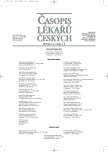Využití psychoterapie u pacientů s kombinovanými epileptickými a neepileptickými záchvaty
Use of Psychotherapy in Patients with Combined Epileptic and Nonepileptic Seizures
Nonepileptic seizures can be divided according to the aetiology of their origin into two main groups:
as somatically or psychogenically determined. The group of psychogenical nonepileptic seizures has not been clearly defined and it has no generally accepted terminology. In the model used in this article, psychogenic seizures can be classified according to the conscious and unconscious control. Differential diagnostics is difficult and an interdisciplinary cooperation is required. The therapy is problematical; especially the treatment of patients with combined seizures that could be therefore considered as pharmaco-resistant. In such cases it is necessary to combine antiepileptic medication with psychotherapeutic techniques. The psychotherapeutic techniques used in the presented case are, among others, following: Rogers’s psychotherapy, techniques of selfregulation and relaxation, and Leuner’s imaginative technique. Significant seizure reduction was achieved after two years of the joint effort of the neurologist and psychologist treating a 34-year-old woman who suffered from combined seizures. She was temporary regarded as pharmaco-resistant with a prominent anxiety disorder verging to social phobia. After four years of treatment, she has had no seizures for the recent eight months, she had no problems in the social communication either and she has been also without the characteristic anxiety features.
Key words:
epileptic, nonepileptic seizures, psychotherapy, Leuner’s imaginative technique.
Autoři:
D. Chmelařová
Působiště autorů:
Neurologická klinika LF UK a FN, Plzeň
Vyšlo v časopise:
Čas. Lék. čes. 2005; 144: 557-559
Kategorie:
Kazuistika
Souhrn
Neepileptické záchvaty můžeme podle etiologie vzniku rozdělit do dvou základních skupin na somaticky a psychogenně podmíněné. U psychogenních neepileptických záchvatů je situace dosud značně nepřehledná a neexistuje zde jednotná terminologie. V článku je použit model rozdělující psychogenní záchvaty z hlediska vědomé a nevědomé kontroly. Diferenciální diagnostika je obtížná a vyžaduje mezioborovou spolupráci. Terapie je komplikovaná zejména u pacientů s kombinovanými záchvaty, kteří mohou být proto často hodnoceni i jako farmakorezistentní. V těchto případech je nutno kombinovat antiepileptickou medikaci s psychoterapeutickými technikami.V uváděné kazuistice je v psychoterapeutické oblasti mimo jiné užita technika Rogersovské psychoterapie, autoregulační a relaxační techniky a Leunerova imaginativní technika katatymního prožívání obrazu. Výsledkem společné péče neurologa a psychologa u 34leté pacientky, která měla kombinované záchvaty, přechodně hodnocené jako farmakorezistentní, a s výraznou úzkostnou poruchou na hranici se sociální fobií, bylo po 2 letech významné snížení počtu záchvatů. Po 4 letech je již 8 měsíců zcela bez záchvatů, bez potíží v oblasti sociální komunikace a bez výraznějších anxiózních rysů.
Klíčová slova:
epileptické, neepileptické záchvaty, psychoterapie, Leunerova imaginativní technika.
Štítky
Adiktologie Alergologie a imunologie Angiologie Audiologie a foniatrie Biochemie Dermatologie Dětská gastroenterologie Dětská chirurgie Dětská kardiologie Dětská neurologie Dětská otorinolaryngologie Dětská psychiatrie Dětská revmatologie Diabetologie Farmacie Chirurgie cévní Algeziologie Dentální hygienistkaČlánek vyšel v časopise
Časopis lékařů českých

- Top zaměstnavatelé ve zdravotnictví si hýčkají už studenty
- Přerušovaný půst může mít významná zdravotní rizika
- Ukažte mi, jak kašlete, a já vám řeknu, co vám je
- Metamizol jako analgetikum první volby: kdy, pro koho, jak a proč?
- Horní limit denní dávky vitaminu D: Jaké množství je ještě bezpečné?
Nejčtenější v tomto čísle
- Úrazy hlavy a alkohol
- Transplantace jater dítěte od živého příbuzenského dárce
- Bolest paty
- Výživa kojenců a batolat: Doporučení WHO a informace, se kterými se setkávají čeští rodiče
